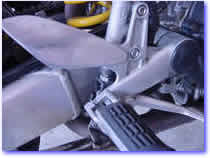![]()
Ergonomics are almost as important as Reagan-omics but don't cause as much pain. The position of the controls determines how you can operate them, and I have heard the brakes and such are kinda important. Many riders don't bother adjusting the controls, they just adjust their riding style to fit the bike. Since you paid for the bike, not vice-versa, the bike should change to fit you (like a good wife!!).
The foot controls have adjusters for height. The brake pedal should be set
so it lies just under your foot. In the normal riding position, the pedal  should
not be touching the sole of your boot. If your foot drags on the pedal, the
brake will drag. There are two locknuts against each other on the actuation
shaft of the brake cylinder. Loosen the locknut and twist the other until you
find the pedal height you like. The pedal tip should ride just beneath your
foot to keep it out of the way, but not so far you have to move your foot a
lot to stop.
should
not be touching the sole of your boot. If your foot drags on the pedal, the
brake will drag. There are two locknuts against each other on the actuation
shaft of the brake cylinder. Loosen the locknut and twist the other until you
find the pedal height you like. The pedal tip should ride just beneath your
foot to keep it out of the way, but not so far you have to move your foot a
lot to stop.
The shift lever has a more complex linkage but has a bigger effect on shifting
ability. One of the locknuts is a left-hand thread (a groove around the outside
of the nut is the symbol for backwards threads), but this make it easier to
adjust. Once the locknuts are loosened, just spin the rod to find the right
height. If the lever is too low, it is very hard to find neutral and is easy
to miss a downshift. If the lever is too high, you have to lift your foot off
the peg to downshift and it is easy to miss an upshift.
The pedal should be adjusted to ride just below the sole of your boot in your
normal riding position. Remember to not ride with your foot under the lever:
the closer your foot is to ground, the easier it is to get it stuck in a pothole,
BOTT's dot, curb, stray cat, etc. Keep your toes up out of the way and above
the pedal. Also, check the height while wearing your riding boots and regular
shoes. Thicker boots need the pedal in a different place than street shoes.
I actually want the lever a little lower to get a more positive upshift to second,
but the threads on the shaft are a little short. If I drop it any more, the
ends of the shaft want be engaged enough for me to be confident of their strength.
I am looking into a new longer shaft being made.

The hand levers should be tweaked a bit for best comfort. After loosening the pinchbolts, rotate the levers up or down to find the right spot. Normally, they should line up with the bars such that your hand is inline with your forearm when your fingers are on the levers. If your wrist is bent to reach "up" for the lever, your hands go numb pretty quick from the nerves being pinched in your palm. The large bundle of nerves (carpal or ulna) that send info to your fingers will get pinched, giving your fingers a feeling like they went to sleep. Repeating this stress leads to carpal tunnel syndrome, which can require surgery to fix for some people. With your forearm, wrist, hand, and fingers inline, you can exert more strength and is less stressful. As you can tell from the picture above, my brake lever is higher than my clutch. I have limited range of motion in my right wrist so I adjusted them independently so each side feels best, if not even. But, make sure the levers aren't so low as to hit the bodywork when the bars are turned to full lock. Tightening the bolts afterwards keeps your underwear cleaner during the first ride.